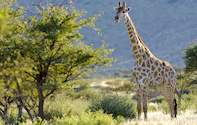
Name
Giraffe [Giraffa camelopardalis]Appearance
The giraffe is the tallest animal in the world, attaining a height of 5.5m, its incredibly long neck accounting for much of its height. The long neck has resulted in a complex blood circulatory system, which is not yet fully understood by zoologists.
Adult males generally reach a height of about 5 metres and females about 4,5 metres. Big males can weigh a massive 1 200 kilograms while females usually weigh some 800 to 900 kilograms. Their skin colour is tan with light brown patches on females and dark brown patches on males. Both males and females have short horns covered in skin.
Diet
Because of their very long necks, Giraffes are able to feed on the foliage of trees that is not accessible to other herbivores. The long prehensile tongue is used to pull pods and leaves into the mouth which are then stripped from the stems with the spatulate incisor teeth.
Breeding
Receptive cows are continuously courted by adult bulls. They have a gestation period of 457 days whereafter a single calf is born. At birth a calf weighs about 100 Kg and they are weaned between six to eight months, but only about 52 per cent of the calves ever reach maturity, since the young are preyed upon by Lions, Hyenas and Leopards.
The sexual maturity of a giraffe is reached after four or five years. The reproductive receptiveness of cows is checked upon by adult bulls moving from group to group.

Behaviour
Giraffes are fairly social animals and get together in herds from time to time. However, there is no group bonding. Youngsters stay with a few adult females and the males are nomadic and move between groups of females. Because Giraffes do not have a fixed breeding season, males are always wandering in search of receptive females.
The male's fight for dominance, and for the right to mate with females, is fascinating to watch. They use their long muscular necks to strike at an opponent's body and wrestle by twining their necks around each other. The loser is pushed off balance and the encounters very rarely lead to serious injury.
Giraffes are generally quiet animals that go about their business with an air of serenity. Occasionally, when disturbed, they will snort and, when attacked by predators, they bellow.

Where Are Giraffe Found
Historicaly the Giraffes distributions has been fragmented through hunting, farming and disease (rinder-pest). However, today conserved populations are thriving and have been widely reintroduced to private ranches and game reserves.
Spoor Description
An unmistakable square-toed print. Giraffes are prone to broken limbs caused by slipping on wet surfaces.Vital Statistics
- Latin Name
- Giraffa Camelopardalis
- Weight (Female)
- 800 kg
- Weight (Male)
- 1 200 kg
- Gestation Period
- 15 months
- No of Young
- 1 calf (exceptionally 2)
- Sexual Maturity
- 4, 5 years
- Birth Weight
- 102 kg
- Order
- Artiodactyla
- Family
- Giraffidae
- Running Speed
- 55 km/h
- Breeding
- A single young is born anytime during the year after a gestation period of about 15 months.
Notes

- Giraffe camelopardarlis camelopardalis - Nubian giraffe found in Sudan and Ethiopia.
- Giraffe camelopardarlis reticulata - Reticulated or Somali giraffe found in Kenya, southern Ethiopia and Somalia
- Giraffe camelopardarlis angolensis - Angolan or Namibian giraffefound in northern Namibia, south-western Zambia, Botswana and western Zimbabwe
- Giraffe camelopardarlis antiquorum - Kordofan giraffe found in southern Chad, Central African Republic, Cameroon and DR Congo
- Giraffe camelopardarlis tippelskirchi - Masai or Kilimanjaro giraffe found in Kenya and Tanzania
- Giraffe camelopardarlis rothschildi - Rothschild, Baringo or Ugandan giraffe found in Uganda and Kenya
- Giraffe camelopardarlis giraffe - South African giraffe found in South Africa, southern Botswana, southern Zimbabwe and Mozambique
- Giraffe camelopardarlis thornicrofti -Thornicroft or Rhodesian giraffe, found only in Luangwa Valley in Zambia
- Giraffe camelopardarlis peralta - West African or Nigerian giraffe
Chitwa Chitwa Giraffes

A great place to see Giraffes is at Chitwa Chitwa lodge in the Sabi Sand Private Game Reserve, bordering Kruger Park. This luxury safari haven offers close encounters of the wild kind.
Best Place to See Giraffe

Satara is the best place to see Giraffes in Kruger National Park. Read more about game drives in Satara and the surrounding area. You can choose to self-drive or go on a guided game drive with an expert wildlife tracker.

